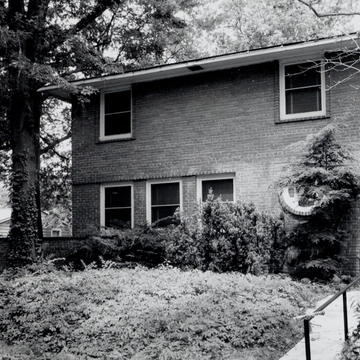Robinson focused on public housing and educational complexes (see NE02) during his long career as an educator and practicing architect in Washington. Single-family houses were uncommon in his oeuvre, the most notable having been erected for fellow Howard University professor Dr. Ralph J. Bunche, who later achieved national fame as a Nobel Peace Prize recipient and undersecretary of the United Nations. Robinson designed a two-story brick residence with shallow hip roof employing the vocabulary and planning principles of the International style that he had witnessed firsthand in Europe. As such it was one of Washington's first modern buildings, a modest house with entry not on its southfacing facade but on the west, behind a brick wall that spans the lot and divides it into a public front yard and private patios. The front facade's asymmetrical composition utilizes five stock rectangular sash windows and one circular one deriving architectural distinction by their placement and interrelationships. Three are grouped together on the ground story to indicate the public nature of the room they light, a reference to International style strip windows. Those on the second story are placed near the house's corners to emphasize both Robinson's abstract facade composition and the private nature of the bedroom story.
You are here
Ralph J. Bunche House
If SAH Archipedia has been useful to you, please consider supporting it.
SAH Archipedia tells the story of the United States through its buildings, landscapes, and cities. This freely available resource empowers the public with authoritative knowledge that deepens their understanding and appreciation of the built environment. But the Society of Architectural Historians, which created SAH Archipedia with University of Virginia Press, needs your support to maintain the high-caliber research, writing, photography, cartography, editing, design, and programming that make SAH Archipedia a trusted online resource available to all who value the history of place, heritage tourism, and learning.

